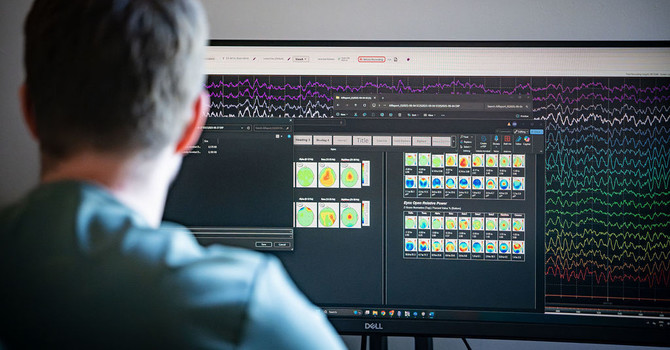
Infra-Low Frequency Neurofeedback & Attention Deficit Hyperactivity Disorder
Attention-Deficit/Hyperactivity Disorder (ADHD) is a neurodevelopmental condition characterized by persistent patterns of inattention, hyperactivity, and impulsivity. While traditional treatments include medication and behavioral therapy, neurofeedback-particularly infra-low frequency neurofeedback (ILF-NF)-has emerged as a promising, non-pharmacological intervention. This blog explores how ILF neurofeedback works and summarizes the evidence from recent journal studies on its effectiveness in managing ADHD symptoms.
What Is Infra-Low Frequency Neurofeedback?
Infra-low frequency neurofeedback is a specialized form of neurofeedback that targets brainwave activity below 0.1 Hz, engaging the foundational regulatory mechanisms of the brain1,4. Unlike traditional neurofeedback, which focuses on training alpha or beta brainwaves, ILF-NF operates in the realm of infra-slow fluctuations, believed to play a critical role in the self-organization and regulation of the central nervous system1,2.
How It Works:
-
Electrodes are placed on the scalp to monitor brain activity.
-
The system provides real-time feedback, often through visual or auditory cues, allowing the brain to adjust its activity toward more optimal patterns.
-
The training is highly individualized, with electrode placement and frequency parameters tailored to each person’s unique neurophysiological profile1,2.
Mechanisms: How ILF Neurofeedback May Benefit ADHD
ADHD is associated with dysregulation in brain networks responsible for attention, impulse control, and arousal. ILF neurofeedback is thought to help by:
-
Regulating Arousal and Network Connectivity: Slow brain activity fluctuations targeted by ILF-NF are linked to the regulation of large-scale brain networks, including those involved in attention and executive function1,2.
-
Improving Metabolic and Neurovegetative Balance: Studies indicate that ILF-NF can enhance the metabolic balance in brain tissue and improve compensatory mechanisms in stress regulation, which are often compromised in ADHD1,2.
-
Increasing Cortical Stability: By training infra-slow oscillations, ILF-NF may reduce excessive cortical excitability, a feature observed in individuals with ADHD1.
What Does the Research Say?
Systematic Reviews and Clinical Studies
A 2022 systematic review published in Frontiers in Human Neuroscience analyzed 18 studies on ILF neurofeedback, including both group and single-case designs. Key findings include:
-
Symptom Improvement in ADHD: In a large cohort study, 196 children with ADHD underwent an average of 38.5 ILF-NF sessions. Results showed improvements in attention, hyperactivity, and impulsivity, as well as enhanced performance on objective attention tests. While the study lacked a control group, the improvements were consistent and clinically meaningful1,2.
-
Individualized Protocols: The effectiveness of ILF-NF appears closely tied to individualized training protocols, which may explain its success in diverse clinical populations1.
-
Broader Regulatory Effects: ILF-NF has been shown to influence not only cognitive symptoms but also neurovegetative parameters such as heart-rate variability and stress response, which are often dysregulated in ADHD1,2,4.
Supporting Evidence from Other Populations
-
Studies have also demonstrated ILF-NF’s efficacy in improving impulsivity and attention in populations with comorbid substance use disorders, further supporting its role in regulating core executive functions1.
-
Research in healthy subjects found that ILF-NF increased spectral power in the 0.016–0.5 Hz band, associated with improved stress regulation and metabolic efficiency in the brain1,2.
Summary Table: ILF Neurofeedback and ADHD
| Feature | Evidence from Journals |
|---|---|
| Target frequency | <0.1 Hz (infra-low frequency) |
| Mechanism | Modulates slow cortical potentials, regulates arousal and network connectivity |
| ADHD symptom improvement | Attention, hyperactivity, impulsivity |
| Individualization | Protocols tailored to each patient |
| Additional benefits | Stress regulation, improved metabolic balance |
| Research quality | Promising, but more controlled trials needed |
Conclusion
Infra-low frequency neurofeedback is a promising intervention for ADHD, offering improvements in attention, hyperactivity, and impulsivity by targeting the brain’s slowest oscillatory activity. While current evidence from systematic reviews and clinical studies supports its efficacy, especially when protocols are individualized, further controlled research is needed to fully establish its clinical utility and optimize its application1,2,4. For individuals seeking non-pharmacological options for ADHD management, ILF neurofeedback represents an innovative and evidence-based approach grounded in the latest neuroscience research.






